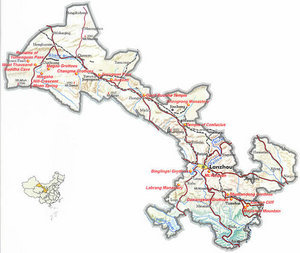Advertisement
Published: April 13th 2009

 Gansu province
Gansu province
It's a really odd shape..If there was a contest for the most oddly shaped administrative region in the world, the Chinese province of Gansu would be a strong contender for the first prize. Stretching from Sichuan in the south to Xinjiang in the north-west, it contains both the geographical centre of China and a border with Mongolia. Chris and I managed to spend substantial amounts of time in Qingdao pondering on how the shape came about while we were probably supposed to be doing our homework.
Lanzhou, the provincial capital, may not be a number one tourist destination, but it is here that we see the Yellow River, the cradle of Chinese civilisation. As we walk across the metal bridge, a man approaches us trying to sell us a ride on a motor boat. When he realises that we are not interested he gives up and starts to chat to us: he has invested in two motorboats and now offers to shuttle tourists up and down the river for RMB50. At the same time he has a small chemical business with his wife and another project in Shanghai. When he hears where we are from he laments how underdeveloped Gansu is compared to Taiwan

 Mogao Caves
Mogao Caves
The entrances to the caves in the cliff face with the mountains towering behind.and the UK. Why does he not go to Shanghai? He can't, his boss won't let him, he has to make some money here first. He seems to epitopmise the Chinese dream held by millions across the country, busying himself with any business he can get his hands on, in the hope of making a fortune and a better life for himself and his family.
Dunhuang is a far cry from Lanzhou. It lies on the other end of the province, past the western most outpost of the Great Wall, an oasis in the desert. Dunhuang sports a strikingly modern railway station and we are greeted by automated announcements in Chinese, English and Japanese. The whole town seems to be undergoing a make-over to cater to the throngs of tourists that find their way here every year. Their reason for visiting Dunhuang lies just outside of the town: the Mogao Caves. Hundreds of caves carved into the cliff face containing magnificent Buddhist paintings from the 3rd to 11th centuries. You can really trace the history of Buddhism in China by these paintings, the earlier ones are distinctly Indian looking while the later ones look more familiarly Chinese. Some paintings
have been chisled from the rock and stolen, others willingly destroyed, but those that remain are stunning and the colours are so vivid it is hard to believe that they have been there for well over a thousand years. All visitors are also taken to the so-called Library Cave, a small alcove that was discovered in 1900 after having been sealed for 800 years. It contained thousands of scrolls and paintings, Buddhist sutras, Confucian classics, historical records and other cultural gems. Soon after their discovery a string of western archaeologists passed through and snapped up a large portion of the treasure, leaving the cave empty. The content is now split between the British Museum, Musee Guimet, Hermitage and others. Having seen the caves myself I suddenly begin to share Dr. Lewis's enthusiasm for all the Buddhas that he showed us on slides in first year..
Dunhuang really is on the edge of the desert: 10 minutes in a taxi and you are faced with an endless view of rolling sand dunes. In true Chinese style, this is now a commercially exploited tourist site and you may enter the desert after purchasing a ticket at the gate. A second fee

 Desert
Desert
A ten minute car ride from the centre of Dunhuang and you are faced with this.gets us a ride on a camel to a mysterious lake at the foot of one of the sand dunes. Camels are wonderful beasts, much comfier than horses (at least the Inner Mongolian variety that come with a plank of wood as a saddle), and while I can't exactly claim that I used it as a means of transport along a the silk road, I feel rather pleased that I managed to stay on board all the way and am considering listing camel riding as a skill on my CV.
Advertisement
Tot: 0.103s; Tpl: 0.013s; cc: 8; qc: 23; dbt: 0.0754s; 1; m:domysql w:travelblog (10.17.0.13); sld: 1;
; mem: 1mb

 Gansu province
Gansu province
 Mogao Caves
Mogao Caves
 No photography allowed inside
No photography allowed inside
 Desert
Desert



Emily
non-member comment
Jealousy is very unattractive but I can't help it
Howdy pardner, I'm very jealous that you've been to Dunhuang. You're bringing Dr L's teachings back to me, though I hope that the next leg doesn't involve bastinado nastiness or courtesan-fox fairies. Lovely writing, can't wait for more. Em x